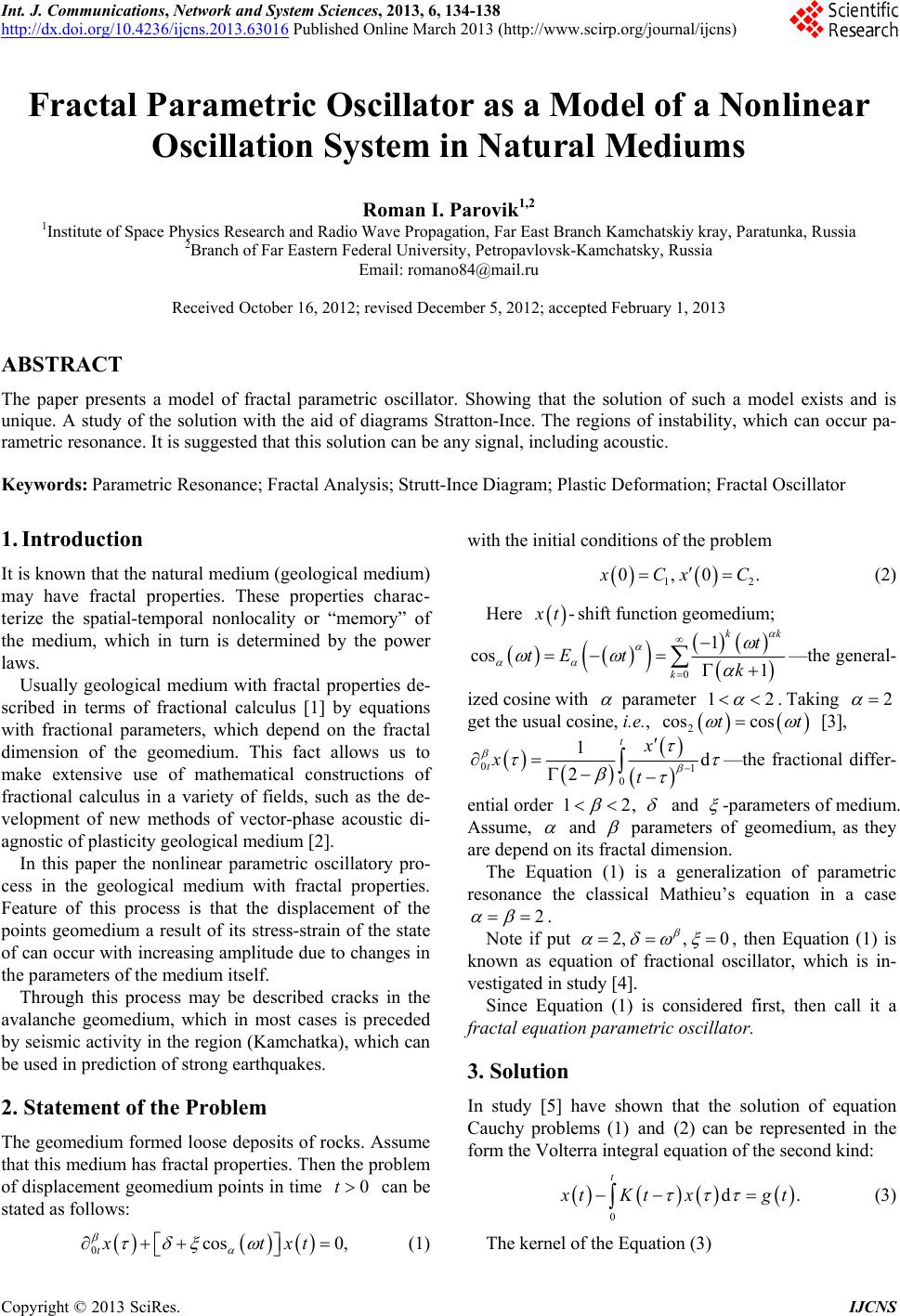 Int. J. Communications, Network and System Sciences, 2013, 6, 134-138 http://dx.doi.org/10.4236/ijcns.2013.63016 Published Online March 2013 (http://www.scirp.org/journal/ijcns) Fractal Parametric Oscillator as a Model of a Nonlinear Oscillation System in Natural Mediums Roman I. Parovik1,2 1Institute of Space Physics Research and Radio Wave Propagation, Far East Branch Kamchatskiy kray, Paratunka, Russia 2Branch of Far Eastern Federal University, Petropavlovsk-Kamchatsky, Russia Email: romano84@mail.ru Received October 16, 2012; revised December 5, 2012; accepted February 1, 2013 ABSTRACT The paper presents a model of fractal parametric oscillator. Showing that the solution of such a model exists and is unique. A study of the solution with the aid of diagrams Stratton-Ince. The regions of instability, which can occur pa- rametric resonance. It is suggested that this solution can be any signal, including acoustic. Keywords: Parametric Resonance; Fractal Analysis; Strutt-Ince Diagram; Plastic Deformation; Fractal Oscillator 1. Introduction It is known that the natural medium (geological medium) may have fractal properties. These properties charac- terize the spatial-temporal nonlocality or “memory” of the medium, which in turn is determined by the power laws. Usually geological medium with fractal properties de- scribed in terms of fractional calculus [1] by equations with fractional parameters, which depend on the fractal dimension of the geomedium. This fact allows us to make extensive use of mathematical constructions of fractional calculus in a variety of fields, such as the de- velopment of new methods of vector-phase acoustic di- agnostic of plasticity geological medium [2]. In this paper the nonlinear parametric oscillatory pro- cess in the geological medium with fractal properties. Feature of this process is that the displacement of the points geomedium a result of its stress-strain of the state of can occur with increasing amplitude due to changes in the parameters of the medium itself. Through this process may be described cracks in the avalanche geomedium, which in most cases is preceded by seismic activity in the region (Kamchatka), which can be used in prediction of strong earthquakes. 2. Statement of the Problem The geomedium formed loose deposits of rocks. Assume that this medium has fractal properties. Then the problem of displacement geomedium points in time can be stated as follows: 0t 0cos 0, txtxt (1) with the initial conditions of the problem 12 0,0.Cx C (2) - Here t shift function geomedium; 0 1 cos 1 kk k t tE tk —the general- ized cosine with parameter 12 2. Taking get the usual cosine, i.e., 2 cos costt [3], 01 0 1d 2 t t x x t 12 —the fractional differ- , and ential order -parameters of medium. Assume, and parameters of geomedium, as they are depend on its fractal dimension. The Equation (1) is a generalization of parametric resonance the classical Mathieu’s equation in a case 2 2,, 0 . Note if put 0 d. t , then Equation (1) is known as equation of fractional oscillator, which is in- vestigated in study [4]. Since Equation (1) is considered first, then call it a fractal equation parametric oscillator. 3. Solution In study [5] have shown that the solution of equation Cauchy problems (1) and (2) can be represented in the form the Volterra integral equation of the second kind: tKtx gt (3) The kernel of the Equation (3) C opyright © 2013 SciRes. IJCNS 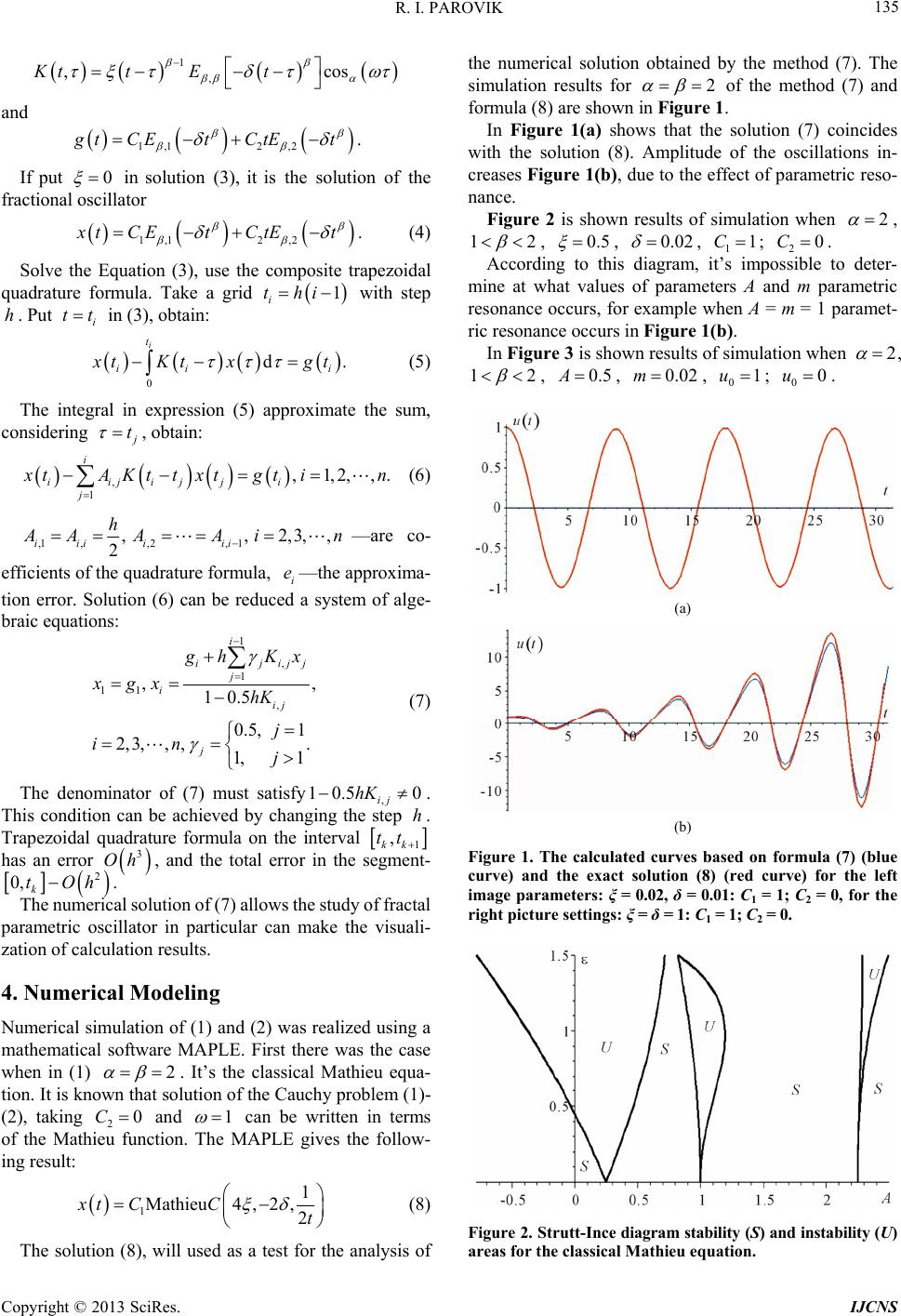 R. I. PAROVIK 135 1 , ,Ktt Et cos 2 ,2 and 1,1 tCEt CtEt 0 . If put 2 ,2 in solution (3), it is the solution of the fractional oscillator 1,1 tCEt CtEt 1 ii hi tt d i . (4) Solve the Equation (3), use the composite trapezoidal quadrature formula. Take a grid th with step . Put in (3), obtain: 0 t ii . i tKt x gt (5) The integral in expression (5) approximate the sum, considering t ,1,2,,. i , obtain: , 1 i iijijj j tAKttxtg ti n (6) ,1,,2, 1 , 2 iiiii h,2,3,, i AA A i n i e —are co- efficients of the quadrature formula, —the approxima- tion error. Solution (6) can be reduced a system of alge- braic equations: 1 , 1 , ,, 10.5 0.5, 1. 1, 1 i ijijj j ij 11 2,3,,, i j hKx hK j j .5 0hK h xg x in (7) The denominator of (7) must satisfy, 10 ij . This condition can be achieved by changing the step . Trapezoidal quadrature formula on the interval 1kk has an error , and the total error in the segment- ,tt 3 Oh 2 tOh 2 0, k. The numerical solution of (7) allows the study of fractal parametric oscillator in particular can make the visuali- zation of calculation results. 4. Numerical Modeling Numerical simulation of (1) and (2) was realized using a mathematical software MAPLE. First there was the case when in (1) 0 1 . It’s the classical Mathieu equa- tion. It is known that solution of the Cauchy problem (1)- (2), taking 2 and C can be written in terms of the Mathieu function. The MAPLE gives the follow- ing result: 1Mathieuxt CC1 4,2, 2t 2 (8) The solution (8), will used as a test for the analysis of the numerical solution obtained by the method (7). The simulation results for 2 of the method (7) and formula (8) are shown in Figure 1. In Figure 1(a) shows that the solution (7) coincides with the solution (8). Amplitude of the oscillations in- creases Figure 1(b), due to the effect of parametric reso- nance. Figure 2 is shown results of simulation when , 12 0.5, , 0.02 , ; . 1 2 According to this diagram, it’s impossible to deter- mine at what values of parameters A and m parametric resonance occurs, for example when A = m = 1 paramet- ric resonance occurs in Figure 1(b). 1С0С 2 In Figure 3 is shown results of simulation when , 120.5A, 0.02m , , ; . 01u00u (a) (b) Figure 1. The calculated curves based on formula (7) (blue curve) and the exact solution (8) (red curve) for the left image parameters: ξ = 0.02, δ = 0.01: C1 = 1; C2 = 0, for the right picture settings: ξ = δ = 1: C1 = 1; C2 = 0. Figure 2. Strutt-Ince diagram stability (S) and instability (U) areas for the classical Mathieu equation. Copyright © 2013 SciRes. IJCNS 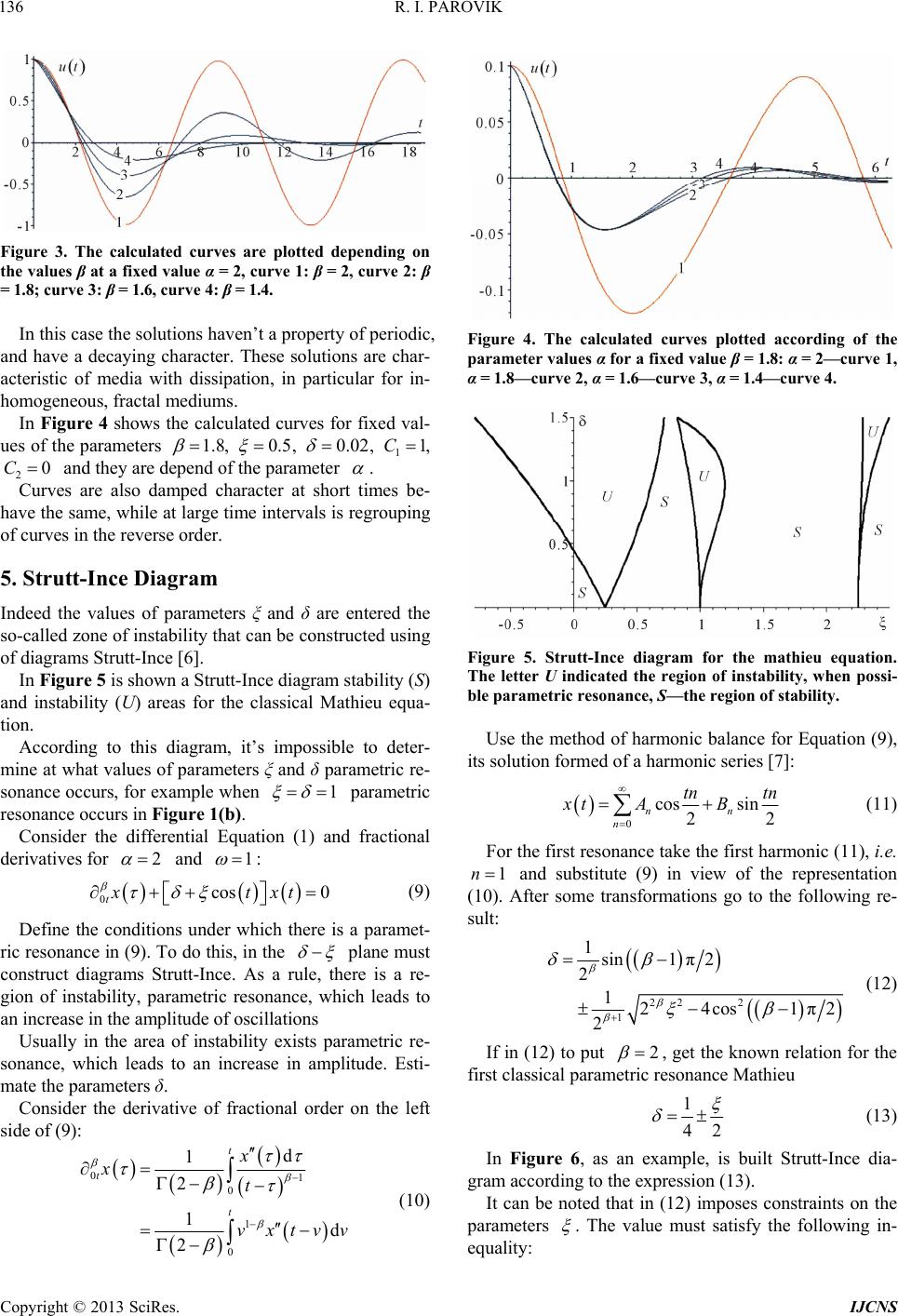 R. I. PAROVIK 136 Figure 3. The calculated curves are plotted depending on the values β at a fixed value α = 2, curve 1: β = 2, curve 2: β = 1.8; curve 3: β = 1.6, curve 4: β = 1.4. In this case the solutions haven’t a property of periodic, and have a decaying character. These solutions are char- acteristic of media with dissipation, in particular for in- homogeneous, fractal mediums. In Figure 4 shows the calculated curves for fixed val- ues of the parameters 1.8 , 0.5 , 0.02 11C, , and they are depend of the parameter 20C . Curves are also damped character at short times be- have the same, while at large time intervals is regrouping of curves in the reverse order. 5. Strutt-Ince Diagram Indeed the values of parameters ξ and δ are entered the so-called zone of instability that can be constructed using of diagrams Strutt-Ince [6]. In Figure 5 is shown a Strutt-Ince diagram stability (S) and instability (U) areas for the classical Mathieu equa- tion. According to this diagram, it’s impossible to deter- mine at what values of parameters ξ and δ parametric re- sonance occurs, for example when 1 2 parametric resonance occurs in Figure 1(b). Consider the differential Equation (1) and fractional derivatives for and 1 : 0cos tx 0txt (9) Define the conditions under which there is a paramet- ric resonance in (9). To do this, in the plane must construct diagrams Strutt-Ince. As a rule, there is a re- gion of instability, parametric resonance, which leads to an increase in the amplitude of oscillations Usually in the area of instability exists parametric re- sonance, which leads to an increase in amplitude. Esti- mate the parameters δ. Consider the derivative of fractional order on the left side of (9): Figure 4. The calculated curves plotted according of the parameter values α for a fixed value β = 1.8: α = 2—curve 1, α = 1.8—curve 2, α = 1.6—curve 3, α = 1.4—curve 4. Figure 5. Strutt-Ince diagram for the mathieu equation. The letter U indicated the region of instability, when possi- ble parametric resonance, S—the region of stability. Use the method of harmonic balance for Equation (9), its solution formed of a harmonic series [7]: 1 d dvxtvv 0 0 1 0 1 2 1 2 t t t x x t (10) 0 cos sin 22 nn n tn tn xt AB 1n (11) For the first resonance take the first harmonic (11), i.e. and substitute (9) in view of the representation (10). After some transformations go to the following re- sult: 22 2 1 1sin1 π2 2 124cos1π2 2 2 (12) If in (12) to put , get the known relation for the first classical parametric resonance Mathieu 1 42 (13) In Figure 6, as an example, is built Strutt-Ince dia- gram according to the expression (13). It can be noted that in (12) imposes constraints on the parameters . The value must satisfy the following in- equality: Copyright © 2013 SciRes. IJCNS 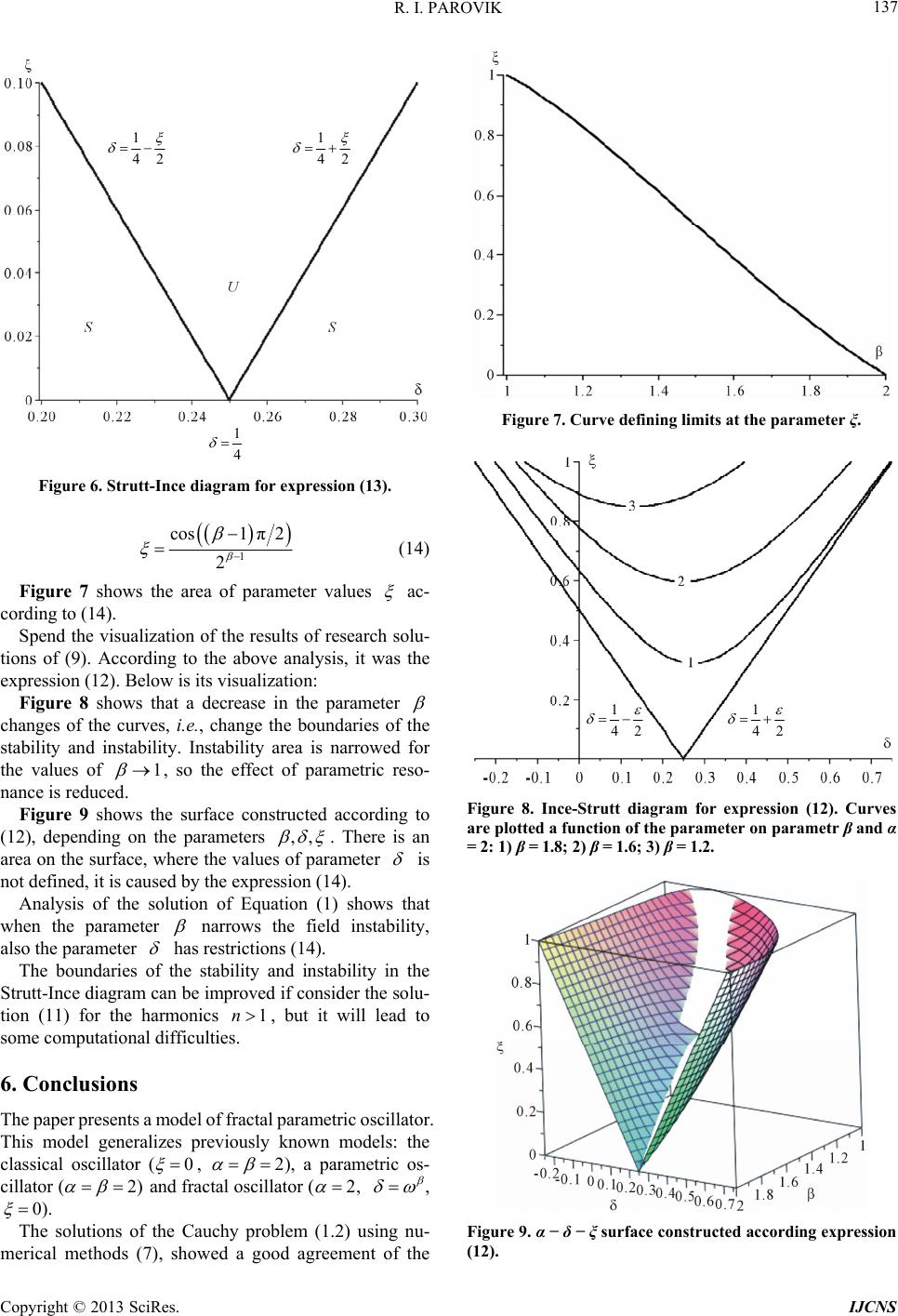 R. I. PAROVIK 137 1 42 1 42 1 4 Figure 6. Strutt-Ince diagram for expression (13). 1 1π2 2 cos (14) Figure 7 shows the area of parameter values ac- cording to (14). Spend the visualization of the results of research solu- tions of (9). According to the above analysis, it was the expression (12). Below is its visualization: Figure 8 shows that a decrease in the parameter changes of the curves, i.e., change the boundaries of the stability and instability. Instability area is narrowed for the values of 1 ,, , so the effect of parametric reso- nance is reduced. Figure 9 shows the surface constructed according to (12), depending on the parameters . There is an area on the surface, where the values of parameter is not defined, it is caused by the expression (14). Analysis of the solution of Equation (1) shows that when the parameter narrows the field instability, also the parameter has restrictions (14). The boundaries of the stability and instability in the Strutt-Ince diagram can be improved if consider the solu- tion (11) for the harmonics , but it will lead to some computational difficulties. 1n 0 6. Conclusions The paper presents a model of fractal parametric oscillator. This model generalizes previously known models: the classical oscillator ( , 2 ), a parametric os- cillator (2 2) and fractal oscillator ( , , 0 ). The solutions of the Cauchy problem (1.2) using nu- merical methods (7), showed a good agreement of the Figure 7. Curve defining limits at the parameter ξ. 1 42 1 42 Figure 8. Ince-Strutt diagram for expression (12). Curves are plotted a function of the parameter on parametr β and α = 2: 1) β = 1.8; 2) β = 1.6; 3) β = 1.2. Figure 9. α − δ − ξ surface constructed according expression (12). Copyright © 2013 SciRes. IJCNS 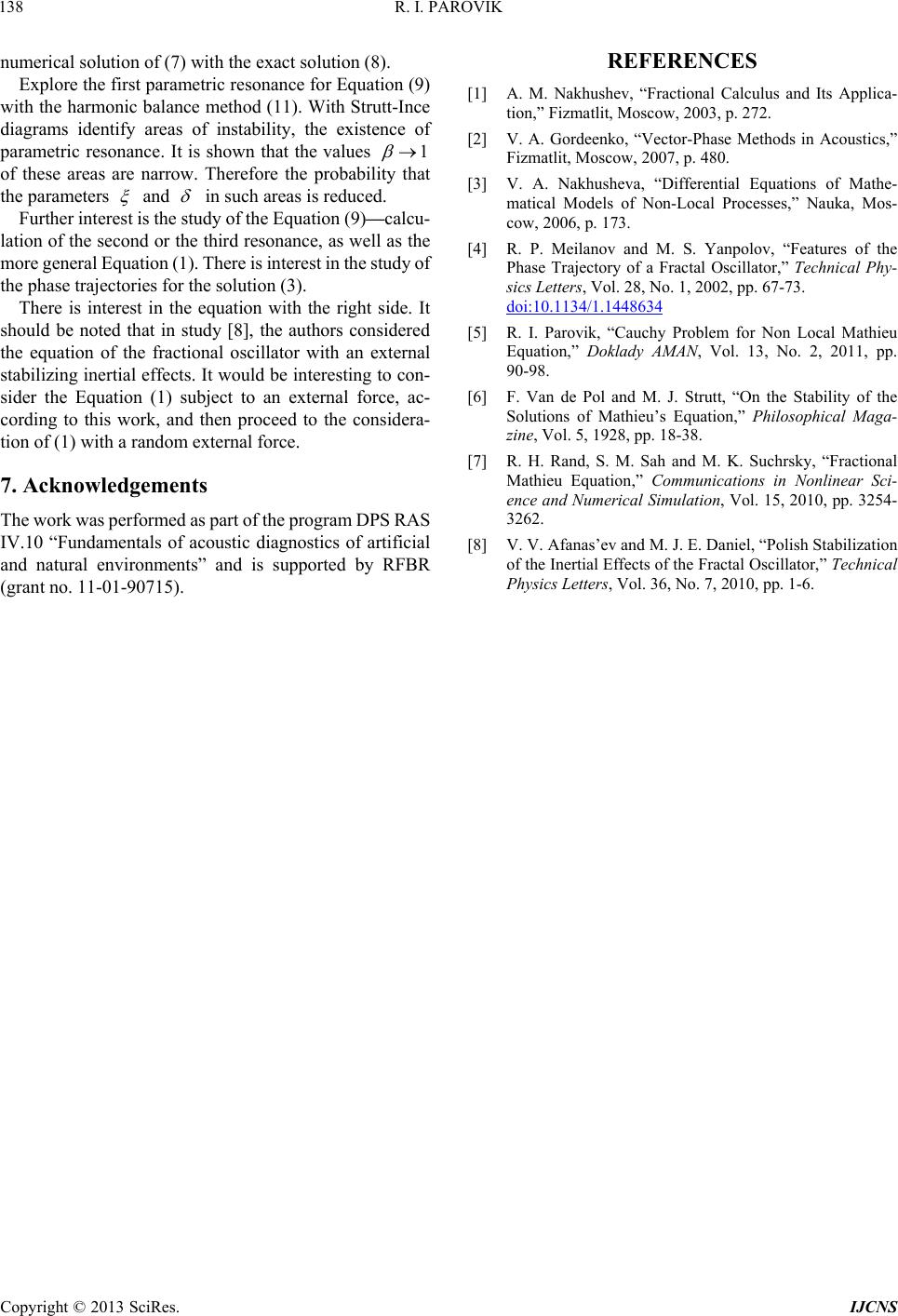 R. I. PAROVIK Copyright © 2013 SciRes. IJCNS 138 1 REFERENCES numerical solution of (7) with the exact solution (8). Explore the first parametric resonance for Equation (9) with the harmonic balance method (11). With Strutt-Ince diagrams identify areas of instability, the existence of parametric resonance. It is shown that the values [1] A. M. Nakhushev, “Fractional Calculus and Its Applica- tion,” Fizmatlit, Moscow, 2003, p. 272. [2] V. A. Gordeenko, “Vector-Phase Methods in Acoustics,” Fizmatlit, Moscow, 2007, p. 480. of these areas are narrow. Therefore the probability that the parameters [3] V. A. Nakhusheva, “Differential Equations of Mathe- matical Models of Non-Local Processes,” Nauka, Mos- cow, 2006, p. 173. and in such areas is reduced. Further interest is the study of the Equation (9)—calcu- lation of the second or the third resonance, as well as the more general Equation (1). There is interest in the study of the phase trajectories for the solution (3). [4] R. P. Meilanov and M. S. Yanpolov, “Features of the Phase Trajectory of a Fractal Oscillator,” Technical Phy- sics Letters, Vol. 28, No. 1, 2002, pp. 67-73. doi:10.1134/1.1448634 There is interest in the equation with the right side. It should be noted that in study [8], the authors considered the equation of the fractional oscillator with an external stabilizing inertial effects. It would be interesting to con- sider the Equation (1) subject to an external force, ac- cording to this work, and then proceed to the considera- tion of (1) with a random external force. [5] R. I. Parovik, “Cauchy Problem for Non Local Mathieu Equation,” Doklady AMAN, Vol. 13, No. 2, 2011, pp. 90-98. [6] F. Van de Pol and M. J. Strutt, “On the Stability of the Solutions of Mathieu’s Equation,” Philosophical Maga- zine, Vol. 5, 1928, pp. 18-38. [7] R. H. Rand, S. M. Sah and M. K. Suchrsky, “Fractional Mathieu Equation,” Communications in Nonlinear Sci- ence and Numerical Simulation, Vol. 15, 2010, pp. 3254- 3262. 7. Acknowledgements The work was performed as part of the program DPS RAS IV.10 “Fundamentals of acoustic diagnostics of artificial and natural environments” and is supported by RFBR (grant no. 11-01-90715). [8] V. V. Afanas’ev and M. J. E. Daniel, “Polish Stabilization of the Inertial Effects of the Fractal Oscillator,” Technical Physics Letters, Vol. 36, No. 7, 2010, pp. 1-6.
|